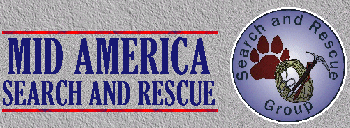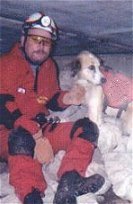MidAmerica Search and Rescue was formed in March of 2001 from members of
other search groups who were unhappy with the politics and practices of the
organizations they had experienced. I wanted to find a different way to
bring talented people and animals together to achieve a common goal of
exceptional service to those in need. Although MASAR has formal policies
and procedures, a high value is placed on the individual's expertise and
aspirations.
Members are encouraged to pursue various aspects of search and rescue
work and choose a path for themselves that allows their own unique
personalities to thrive in a sometimes difficult working environment. This
unconventional approach seems to keep quality motivated volunteers that are satisfied in their position and reliable when they are needed. I want to make the
organization fit the people, not the other way around.
As founder of MASAR, I have been consistently proud of my people and
consider them valued friends. They have performed well in every
situation, from tolerating my woeful computer illiteracy, through tornados,
cadavers and lost children, mosquitoes, poison ivy, and the ever-present
multi-flora rose bushes, their dedication and tolerance humbles me. Thank you
Laura, Dan, MaryJo, Jeanie, John, Kim, Brian, Jeff, all my canine friends and
above all the good Lord without whom this creation would not have been
possible.
Thomas Hale
President and Technical Training Officer
MidAmerica Search and Rescue

 Mission Statement
Mission Statement

1. To provide at no charge and for the benefit of the public, trained ground
searchers, trained canines and handlers for the search of persons lost,
trapped or incapacitated upon the request of any official agency day or
night under any conditions in which a searcher can efficiently operate.
2. To provide current and relevant training to all members and canines
in all types of environments and situations to assure competent and
capable teams.
3. To equip search teams, canines and handlers with state of the art
tools, materials and personal protective equipment to safely, quickly and
efficiently operate in a hazardous environment or situation.
4. To quickly and safely respond to:
- Search for missing or lost persons in wilderness, rural or urban
environments.
- Search for trapped or lost persons in collapsed buildings and
disaster situations.
- Search for drowning victims providing the environment is suitable
and safe for search personnel
5. To cooperate and communicate with other agencies and teams to allow
a quick and efficient resolution to the situation.
6. To assist in cadaver location with appropriate law enforcement oversight.


































